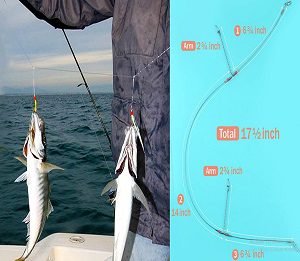
This also applies to your baits, your tackle, and lures, as well as to your rigs. So, when it comes to surf fishing, simplicity is key. Learning how to tie the Fish Finder Rig would not bother you if you love to fish. This clearly explains why minimalist and simple rigs are considered the most recommended for surf fishing. These simple rigs are not only appropriate for their ease of use but also because they manage to provide the most catches.
The Fish Finder Rig is among the most popular surf fishing rig normally used to find where the fish are congregating. It’s quite similar to the Carolina Rig, but rather than a sliding egg sinker, it is usually used with a pyramid weight in order to keep the rig in one area.
Table of Contents
What exactly is a fish finder Rig?
In simple terms, the Fish Finder Rig is just a popular surf fishing rig that is widely used to catch a wide variety of fish like stripers and redfish. It also involves a sliding sinker that enables the bait to move freely when the bait anchors itself towards the bottom.
The fish finder rig is nothing but a line configuration for surf fishing, and it is widely known for its efficiency, simplicity, and obviously appeal to fish. It would not be wrong to think of the fish finder rig as the saltwater version of the Carolina rig.
One of the benefits of the fish finder rig is that it is considered easy to use and does not require you to buy a lot of equipment. Normally, you only need 5-6 items to set it up, but sometimes it depends on which version of the rig you prefer to use.
How does fish finder Rig actually work?
It fights the current, As a heavy Pyramid Sinker right in front of the rig holds up your presentation near the bottom, resisting against the current. The sinker provides ease by kicking Sand, It will gradually move, which is actually good because it kicks up poofs of sand that just imitate a wounded baitfish in front of your presentation.
Plus, at the end of your leader, your bait would be bouncing up and down off the bottom like a wounded baitfish as it just simply reacts against the current versus the sinker. Then, the pyramid sinker is threaded towards your main line by a sinker Slide so that whenever a fish does take your bait, it connects directly to your surf rod via your line.
Follow 5 easy steps to learn to tie a fish finder rig
- Just start by simply cutting a piece of leader line, usually, around 18 inches would be enough.
- Now tie one end to your hook by using a Palomar Knot.
- On the other side of your leader line, just tie on your swivel using a Palomar Knot.
- After you find success in the previous step, now with your mainline, fish the line properly through your pyramid sinker and your bead.
- Tie the mainline to the other side of the swivel using a Palomar Knot. Please note that the Palomar makes it a bit complicated as you need to pull your entire leader line with the hook through to finish the knot. Well, don’t be worried too much about it and just take your time.
Items needed to set it up
When it comes to considering the weights, most anglers opt for lead. Not many people are aware of it, but there are some other options as well that are better for the environment. So, Instead of purchasing storebought weights, try to experiment using steel which will corrode in the saltwater environment if you lose it.
It heavily depends on the fish being targeted, as it will determine which leader line you use. If your plans are to fish around rocks then you should likely prefer monofilament which is comparatively more abrasion resistant than fluorocarbon. The plastic bead is also important as it helps protect your line from your weight in the water. If you are planning to ignore the use of it, you are just risking an unnecessary breakoff of your line.
It is very important to choose the hook size that is based on your bait. For instance, If plan to go after perch and use sand crabs, your hook will be around a #6. Well, if you prefer going after bigger fish and looking forward to using a chunk of cut bait, then it would be better to think about going up to a #2 or even more. It is recommended to use circle hooks as they are self-setting.
- What Do You Need for Fishing - August 18, 2022
- How to Find Offshore Fishing Spots - August 18, 2022
- What to Use for Trout Fishing - August 17, 2022
